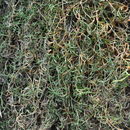Comments
provided by eFloras
Selaginella oregana , one of the most distinct species in the flora, is easily distinguished by its usually long, epiphytic-pendent stems, slightly loose strobili, and curled branches (in dry specimens). In the flora, S . oregana is most closely related to S . underwoodii . It is sometimes confused with S . wallacei (see discussion), and it shares some characteristics with the Mexican species, S . extensa L. Underwood. In S . oregana , very often where a branch fork occurs, one of the branches is arrested (R. M. Tryon 1955). The strobili of S . oregana are among the longest in the flora, and they often show several novel features. Very often the apex of a strobilus undergoes a period of vegetative growth, thus becoming a vegetative shoot, and after an interval the apex reverts to the fertile condition, forming a strobilus again. In other cases, the strobilus forks, giving rise to two new strobili.
- license
- cc-by-nc-sa-3.0
- copyright
- Missouri Botanical Garden, 4344 Shaw Boulevard, St. Louis, MO, 63110 USA
Description
provided by eFloras
Plants usually epiphytic, less often terrestrial, forming festoonlike mats. Stems radially symmetric, long-pendent, not readily fragmenting, irregularly forked, without budlike arrested branches, tips straight; main stem indeterminate, lateral branches determinate, ascending, 1-forked. Rhizophores borne on upperside of stems, restricted to base of pendent stems, or borne throughout on terrestrial stems, 0.13--0.2 mm diam. Leaves monomorphic, in alternate pseudowhorls of 4 (on main stem) and 3 (on lateral branches and secondary branches), loosely appressed, ascending, green, narrowly triangular-lanceolate to linear-lanceolate, 2--3.35 X 0.4--0.6 mm; abaxial ridges prominent, often flanked by two bands of cells (several rows wide) with whitish papillae (only in S . oregana , better seen on dry leaves); base cuneate and strongly decurrent on main stems and lateral branches or rounded and slightly decurrent to adnate on secondary branches, glabrous (seldom pubescent); margins entire or with very short cilia or denticulate, cilia few, transparent, scattered, ascending to slightly spreading, dentiform toward apex, 0.02--0.04 mm; apex slightly keeled, long-attenuate, short-bristled; bristle (hard to distinguish from apex) transparent or greenish transparent to yellowish or brownish (in old leaves), smooth, sometimes breaking off, (0.07--)0.17--0.4 mm. Strobili often paired, 1--6 cm; sporophylls lanceolate to narrowly ovate-lanceolate, abaxial ridges prominent, base glabrous, margins short-ciliate to denticulate (at middle), entire toward both base and apex, apex keeled to plane, short-bristled or merely long-attenuate.
- license
- cc-by-nc-sa-3.0
- copyright
- Missouri Botanical Garden, 4344 Shaw Boulevard, St. Louis, MO, 63110 USA
Distribution
provided by eFloras
B.C.; Calif., Oreg., Wash.
- license
- cc-by-nc-sa-3.0
- copyright
- Missouri Botanical Garden, 4344 Shaw Boulevard, St. Louis, MO, 63110 USA
Habitat
provided by eFloras
Pendent on trunks and branches of mossy trees ( Acer macrophyllum Pursh, Populus trichocarpa Torrey & A. Gray ex Hooker, and Alnus rubra Bongard) or on deep-shaded and moist rocky banks; of conservation concern; 0--200m.
- license
- cc-by-nc-sa-3.0
- copyright
- Missouri Botanical Garden, 4344 Shaw Boulevard, St. Louis, MO, 63110 USA
Selaginella oregana: Brief Summary
provided by wikipedia EN
Selaginella oregana is a species of spikemoss known by the common name Oregon spikemoss. It is native to the Pacific Coast of western North America, where it can be found from British Columbia to northern California. It grows in mossy, shady coastal forests. It is often epiphytic, growing attached to tree branches, its stems hanging in sheets of green, mosslike streamers. Trees commonly occupied by the spikemoss include bigleaf maple (Acer macrophyllum), black cottonwood (Populus trichocarpa), and red alder (Alnus rubra). It also grows on the ground and on rocks in carpetlike mats. This lycophyte has creeping or hanging stems up to about 60 centimeters long, usually with forking branches. They curl as they dry. The stems are radially symmetric, with spirals of lance-shaped leaves each measuring 2 or 3 millimeters in length and tipped with a tiny, rigid bristle. The strobili containing the reproductive structures are up to 6 centimeters long and often occur in pairs.
- license
- cc-by-sa-3.0
- copyright
- Wikipedia authors and editors

